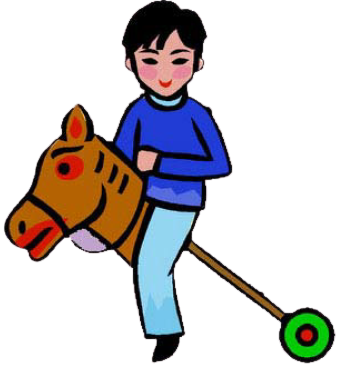Introduction
Use these milestones as a guideline to gauge how your preschooler is growing and acquiring new skills.
A preschooler’s life, ages 3 to 5 years is a time of amazing learning and development. Remember that every child is unique and will develop at his own pace. Some grow faster than others, and some grow slower than others. If your child is slower or faster than on the brochure, do not get upset. Be patient. If you have any questions, ask your child’s doctor or nurse.

I'm a Preschooler and Look What I Can Do!
I am 3 years old and I may:
- Sleep 10-17 hours at night.
- Dress myself with some help.
- Feed myself with some help.
- Kick a ball forward.
- Hop on one foot.
- Pedal a tricycle.
- Develop a taller, thinner, more adult-like appearance.
- Brush my teeth.
- Wash my hands.
- Get a drink of water.
- Speak so that 75-80% of my speech is understandable.
- Listen attentively to short stories.
- Understand “now, soon and later.”
- Ask “who, where and why” questions.
- Know some colors.
- Match objects.
- Enjoy playing alone but near other children.
- Accept suggestions and follow simple directions.
- Enjoy helping with simple household tasks.
- Sometimes show preference for one parent.
- Seek attention and approval of adults.
- Not cooperate or share very well.
- Enjoy hearing stories about myself.
- Make simple choices between two things.
- Repeat common rhymes.
- Use a toilet but still wear a diaper at night.
- Open door by turning knob.
- Scribble with circular motion.
- Draw or copy vertical lines.
- Walk up and down stairs using alternating feet.
I am 4 years old and I may:
- Feed myself with very little assistance.
- Pedal and steer a tricycle skillfully.
- Form objects out of clay and not eat the clay.
- Like to gallop.
- Turn somersaults.
- Climb ladders and trees.
- Dress myself with very little assistance.
- Hop on one foot.
- Thread beads on a string.
- Recognize familiar words in books and on signs.
- Count one to seven objects out loud.
- Continue an activity for 10 to 15 minutes.
- Understand passage of time (yesterday, tomorrow).
- Understand concepts of size, shape, color.
- Understand concepts of distance and time.
- Enjoy playing with other children.
- Seek adult approval.
- Understand and obey simple rules.
- Change rules of games as I go along.
- Tattle.
- Like to talk and have conversations.
- Use unsuitable words to “shock” you.
- Be capable of feeling jealous.
- Be boastful.
- Enjoy showing off and bragging.
- Be fearful of dark and monsters in the closet.
- Begin to understand danger.
- Be able to tell you where I live.
- Have difficulty separating make-believe from reality.
- Challenge your authority.
- Be always on the go.
- Like to test new skills and abilities.
- Often be “out of bounds.”
- Like to play pretend.
- Like to make up stories.
- Begin to copy big letters.
- Zip my coat.
- Be pretty well potty-trained.
- Be able to draw a picture that looks like something I know.
- Have bad dreams at night.
I am 5 years old and I may:
- Learn to skip.
- Throw a ball overhand.
- Be able to balance on one foot for 5 to 10 seconds.
- Cut a line with scissors.
- Jump over low objects.
- Begin to lose baby teeth.
- Sleep 10 to 11 hours a night.
- Like doing tricks, like standing on my head.
- Like doing dance steps.
- Be able to tie shoelaces.
- Understand about 13,000 words.
- Like to argue.
- Use words like “because.”
- Be able to memorize my address.
- Be able to memorize my phone number.
- Sort objects by size.
- Have good attention span.
- Concentrate quite well.
- Invent games with simple rules.
- Organize other children and toys for pretend play.
- May often exclude other children in play -- best friends only.
- Boast about self to younger, less capable children.
- Like to share jokes.
- Still confuse fantasy with reality sometimes.
- Fear loud noises.
- Fear the dark.
- Fear some animals.
- Take turns and share but I don’t always want to.
- Like to try new things.
- Like to take risks.
- Be sensitive to others’ feelings.
- Be bossy.
- Like to talk about things I see.
- Like to talk about things I know.
- Be able to do one or two simple tasks to completion at a time.
- Love body movement.
- Learn to jump rope.
- Play along with imaginary playmates.
- Seek approval when I learn a new skill.
- Love dramatic play with theme props.
- Be able to tell parents’ names.
- Be able to point to body parts correctly.
- Name more than five colors.
- Count to 10 or higher.
- Be able to copy patterns.
Resources
- Byington, Teresa. (1998). Child Development: Understanding the First Five years. Curriculum: Utah State University Extension.
- Kock, J., Agao, V., Sigman-Grant, M., Martin, S., Reilly, J., Weigel, D., Bixler, M., & Papa, M. (2005). Follow My Lead: Developmentally Appropriate Physical Activities for Young Children. Curriculum Material-05-13, University of Nevada, Reno Cooperative Extension.
- Marion, M. (1995). Guidance of Young Children. 4th Edition. Englewood Cliffs, NJ, Merrill.
- P.E.P. Post. (2006). Developmental Milestones. Volume 9, Issue 2, Las Vegas, NV.
- National Network for Child Care, Ages and Stages. Oesterreich, L., Iowa State University.
- Popkin, Michael. (1996). 1,2,3,4 Parents: Parenting Children Ages 1 to 4. Active Parenting Publishers, Atlanta, Georgia.
Kock, J.
2006,
Developmental Milestones For Preschoolers,
Extension | University of Nevada, Reno, FS-06-79


